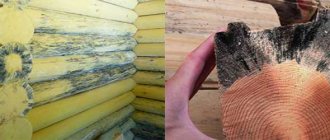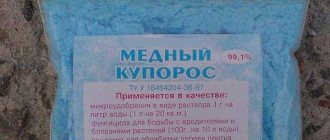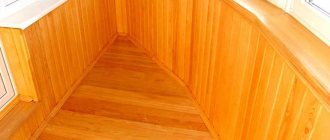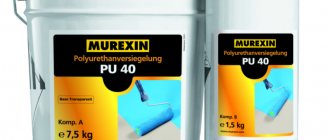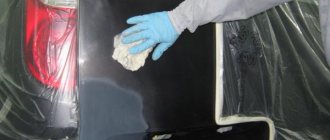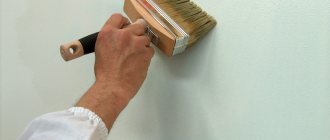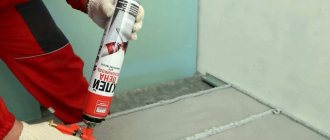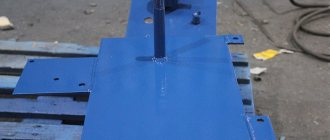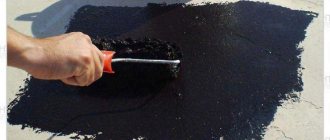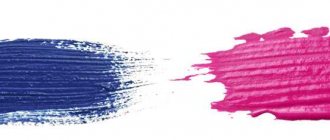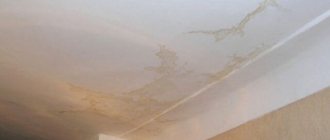Deep penetration antifungal primer for concrete is a means that helps prevent the appearance and proliferation of spores of dangerous microorganisms on the surface. The treatment is carried out using special substances at the final stage of construction, before the start of work on the decorative finishing of the walls.
Due to the fact that concrete has a porous structure, spores of microorganisms very easily penetrate into the base where a favorable environment is created for their growth. The fungus multiplies extremely quickly; treating surfaces is much more expensive and requires much more effort and time than prevention with antifungal drugs.
Danger of fungus and mold
Mold usually appears where concrete bases are exposed to moisture, steam, or strong temperature changes. In residential premises, these are bathrooms, bathrooms, kitchens, rooms where the heating is not constantly turned on, etc. It is better to treat all surfaces where there is a risk of the spread of microorganisms prophylactically, without waiting for a problem to arise.
After all, fungus and mold are very dangerous to health - they release mycotoxins, their spores spread by airborne droplets, quickly enter the respiratory organs, causing a number of health problems: chronic fatigue, decreased immunity, allergic reactions, migraines, diathesis, bronchitis, asthma, rhinitis , otitis. In cases of severe infection, even problems in the functioning of the cardiovascular system, irreversible damage to internal organs, and cancer are possible.
In addition, the spores penetrate deep into the material and the fungus quickly destroys the surface on which it appears. And literally a few months after the first dark spots appear, the finish becomes loose, peels off freely, collapses and literally burns.
Getting rid of fungus is extremely difficult - in the process of treating a surface, you must carefully follow safety rules, wash all clothes at once, use special tools and means to prevent the spread of flying invisible spores further throughout your home, and prevent them from entering the respiratory tract. It is much easier and safer to immediately treat substrates in rooms with high humidity, so as not to give the parasite a chance.
Causes of fungal pores and their danger to humans
We apply an antifungal primer mixture to the walls ourselves
Mushrooms that grow in the forest and black spots of mold on the walls are relatives. They come in different sizes and degrees of utility. The latter, like all parasites, are much more tenacious than their edible relatives, bring a lot of trouble, and are difficult to remove.
Mold requires certain conditions to grow. The main thing is moisture, or rather dampness. It can form for various reasons.
- In case of violation of foundation waterproofing. Soil moisture rises up the wall.
- Freezing of walls with poor protection of the facade from moisture.
- Violation of the rule of vapor permeability during insulation, then the moisture does not come out, but remains inside.
- The use of finishing materials that do not allow air to pass through and the walls cannot breathe. Porous textures of wood, plaster.
- Leaking pipes at joints and small cracks.
- Formation of dew in plastic windows.
- Poor ventilation in the kitchen, bathrooms and utility rooms.
The smell of stale air is created by millions of pores flying around in the room. They are harmful to humans. Entering the body through the respiratory system, they can cause a number of serious diseases. The fungus takes deep roots in wall materials and promotes rapid destruction.
Related article: How to choose linoleum: for an apartment or house, correct and high-quality for the hallway, good corridor and marking
Signs and causes of fungus formation
Impregnation against mold and mildew for concrete is used at the stage of repair and construction work. However, for high-quality protection of premises, it is necessary to study the causes of the appearance of fungus and the “symptoms” of infection, which will help to avoid problems in the future and take into account all the nuances.
The main signs of the spread of microorganisms:
1. The appearance of dark gray or black, dark green spots and dots on the ceiling, walls, floor
2. Clearly noticeable damp musty aroma
3. Destruction of the exterior finish - wallpaper peels off, a layer of plaster falls off, wooden panels move away from the base, tile seams darken
4. Deterioration in general well-being in the absence of any diseases - fatigue, poor sleep, headaches, decreased immunity, deterioration of attention and memory
The main causes of mold:
- Poor protection of the base from moisture and cold, ignoring the need to install thermal insulation and waterproofing
- Poor quality processing of interpanel joints, as a result of which they freeze
- Poor condition of the roof, freezing of the attic
- Incorrect installation of window units, absence or poor operation of the ventilation system
- Unprofessional performance of thermal insulation, as a result of which there is no normal vapor permeability
- Unsatisfactory condition of plumbing - pipes are leaking, taps are leaking, water splashes when bathing, stagnates in cracks
Purpose and application
Mold primer is a durable mixture that is applied to materials during indoor and outdoor construction work. You can process not only the walls of rooms, but also the facades of houses. The primer gives the surface strength. It provides protection against the following factors:
- Corrosion.
- Peeling.
- Moisture.
- Cold.
This mixture can be dry or already diluted. It can protect foundation walls and process joints between panels. If a house has a dilapidated roof, soil is sometimes applied to the supporting beams for additional protection. The composition helps improve the functioning of the ventilation system and protects the surface from moisture.
Primer is a tool for fighting mold
Antifungal impregnation for concrete is a special product, the composition of which is designed to protect surfaces and neutralize mold spores, preventing their appearance in principle. As a rule, such compounds are used to treat floors, ceilings, and walls in rooms with high humidity levels. The work is carried out at the rough finishing stage - the fungicide is added to the primer and guarantees maximum penetration into the pores of the concrete.
Mold can infect a variety of materials, so for each type of work it is worth choosing a product that is suitable for interacting with brick, wood, concrete, etc. In accordance with the purpose, the compositions are ordinary and deep penetration. The second type of product can also be used to treat already contaminated surfaces and is characterized by a longer operating life.
Types of primer by composition:
1) Acrylic – improves the adhesion of materials, is non-toxic, dries quickly, and is used for treating rooms exposed to high humidity (processing the external surfaces of walls, floors, basement ceilings, bathrooms, kitchens, swimming pools, etc.).
2) Alkyd - for glass, plaster, drywall, tiles, wood (the composition protects the wood from swelling).
3) Mineral - for brick and concrete mortar, applied to silicate materials, a layer of plaster, containing cement and gypsum, natural substances, non-toxic.
4) Quartz - applied under the finishing layer of plaster, under paint, contains sand, which guarantees excellent adhesion to surfaces. The final layer is rough.
Substances based on silicate and epoxy resins, shellac, polystyrene, toxic aluminum, polyvinyl acetate, etc. are also used.
Peculiarities
Anti-mold primer has its own characteristics:
- It has a strengthening effect and prolongs the durability of the structure.
- Provides additional adhesion to other materials.
- Levels walls for wallpapering.
- Allows you to reduce mixture consumption due to the fact that it is enough to apply a thin layer.
- Prevents the formation and proliferation of fungus, corrosion and mold.
- Absorbs the smell of paintwork.
- Fills pores and blocks mold growth.
- Reduces toxicity significantly.
To meet the hopes of builders, the mixture must be of high quality. It can become a base coat for any material. Experts advise buying the product only for professional use and not choosing a substance based on pricing.
Types of antifungal primer
The specifics of using anti-mold impregnation for concrete determine its properties. First of all, all formulations are divided into two main types: for prevention and treatment. Often the concentrate combines both of these properties and is used in diluted form for preventive work and highly concentrated in the treatment of infections.
Products can be oily, adhesive, resinous, demonstrate the ability to absorb moisture, simplify the application of the finish, change its properties and protect. Therefore, the first rule for choosing a substance is to take into account the material on which it will be applied: there are impregnations for concrete, brick, wood, drywall, plaster, protective agents for tiles, etc.
Impregnation against mold and mildew on concrete is intended for use exclusively on this type of surface and is not suitable for other materials.
Types of fungicidal compounds according to action:
- Deep penetration – for strengthening porous surfaces, with penetration up to 5 centimeters
- Adhesive - covered with a thick film with adhesive ability
- Penetrating – for strengthening the composition (plaster and concrete) to a depth of 5 millimeters
- A special-purpose product - with special properties relevant for a specific task: frost-resistant, anti-corrosion, etc.
Based on the type of base, antiseptic compositions are divided into:
1) Water-soluble - diluted with water, low toxicity, used for indoor use. Copper sulfate, which comes in blue powder format, was often used in the past. It is dissolved in a ratio of 1:100 with water and the surface is covered 3-4 times. Calcium fluoride, used as an additive in plaster mortar, belongs to the same type.
2) Organic - very toxic, not used in residential areas, added as an additive when preparing concrete mortar, relevant where there is a high risk of mold.
3) Oil-based (phenol, creosote, carolineum, etc.) – toxic, can only be used externally.
4) Combined - complex chemicals supplied in the form of concentrates. They are diluted with water and used on concrete before applying plaster or as part of it. They guarantee reliable protection provided the right choice is made.
By surface type:
- Strengthening primers - for walls covered with plaster and putty for wallpapering or painting
- Deep penetration primers - for low porosity substrates (concrete, brick, plasterboard, tiles)
- Universal compositions - for any materials.
How to choose the right anti-mold product
There are several types of compositions, differing in areas of application and methods of influencing microorganisms. All of them can be used on different surfaces. They are selected according to the strength of damage to surfaces and the type of base.
Fungicidal agents
Most anti-fungal products contain fungicides. These substances are of chemical or biological origin. They suppress the development of fungi, but are not always very effective at destroying already developed mold. These compounds are added to various building mixtures during the construction stage, that is, they are used to prevent the development of microorganisms.
Combined antiseptic for black mold
Products with fungicides are divided into preventive (primers and impregnations) and concentrates (these compositions instantly destroy mold).
Soils for different bases
Primers are used during construction work. In addition to antiseptic, they have the following properties:
They reduce the degree of hygroscopicity of the base due to deep penetration into its structure and crystallization there, entering into a chemical reaction. They improve adhesion - the property of adhesion to materials of different types (it is important to choose the composition specifically for the base). They form a durable film on the surface, binding fine dust. Strengthens mineral bases.
Acrylic-based deep penetration primer
In general, this treatment is quite effective, but over time its properties are lost and mold can begin to multiply. Such compositions can be used on the following surfaces:
Putty and plastered gypsum walls - the strengthening and dust-binding properties of the material are important here. The composition must be applied after each layer of finishing.
This way the base is better saturated and the adhesion with finishing materials is much better.
Drywall - this material already has good adhesion, so its penetrating property is important. The soil will saturate the inner layers of plaster and prevent mold from growing there. Concrete - almost everything is the same as with gypsum
If the surface of the material crumbles, it is better to use soil with quartz filler to strengthen it. Bricks and all kinds of blocks are all hygroscopic to varying degrees; soil helps to effectively reduce this property, which is unpleasant for the foundation.
Concentrates and their use
Concentrated products can be used both as a primer and to kill mold on surfaces. The first compositions are also called combined.
Concentrated antiseptic for concrete against mold and mildew
Essentially, this is a powerful poison that quickly and easily kills mold, lichens, and mosses. It must be used carefully, always wearing a respirator and protective gloves. Many compounds have a long-lasting effect and continue to protect surfaces for a long time. Take this point into account when purchasing, read the instructions carefully.
The binder in such antiseptic emulsions can be:
- Acrylic – creates a film on the surface. Can be used both outside and inside the building. Suitable for all mineral substrates.
- Latex - these emulsions do not contain heavy salts, so they are suitable for residential premises. After treatment, the surfaces remain vapor permeable.
- Alkyd compounds - they are used mainly for wood processing.
Working with antifungal primer
Products for walls, floors, and concrete ceilings are selected in accordance with the assigned tasks and the characteristics of the operation of the room. But a number of works are usually performed in a similar way. Each stage plays a very important role in achieving the final result and should not be ignored.
The main stages of surface treatment tasks:
- If this is not prevention, then you first need to identify the causes of the appearance of microorganisms and eliminate them - arrange ventilation, perform waterproofing, change pipes, repair plumbing, etc.
- Using a solution of water and detergent (mostly bleach is used), use a cloth to wash all stains. Burn the rag and everything that interacted with the spores.
- Dry the clean surface by opening windows or using heating appliances.
- Remove contaminated areas of trim.
- Treat the areas freed from infection with a torch or blowtorch, dry and disinfect.
- Clean the surface, remove dust and carbon deposits.
- Apply the primer, wait - it will take a certain time to dry, specified in the instructions for the substance.
- Perform new finishing.
The primer for concrete and mold is applied with a paint brush; in large areas, a roller is used; for large surfaces, a spray bottle is used. The layer of the substance should be dense and even, the calculation is approximately 500 milliliters per 1 square meter, it is better to process several times. To avoid bald spots, layers are applied perpendicular to one another; thanks to rubbing movements, you can be sure that the composition has sunk deeply. It is better to fight inside and outside at the same time.
During work, it is mandatory to use personal protective equipment - close-fitting goggles, a respirator, rubber gloves, thick overalls, and a hat. Upon completion of work, wash the overalls (do not clean them, spreading spores everywhere), wash everything that is disposable - throw it away or burn it.
It is not recommended to use a regular primer on affected surfaces. This product has the property of creating a film on the surface, as a result of which the lesion will be protected, actively growing inward and multiplying.
Primer manufacturers
- Mill kill - consumption about 250 g/sq.m, the composition penetrates well into walls up to 3 millimeters deep, dries in 24 hours, suitable for interior and exterior decoration, strengthens fragile and porous materials, suitable for use in damp rooms, applied in 2- 3 layers.
- “Areal-Primer” is an acrylic-based substance that includes fungicides of various effects, protects against bacteria, and is important for prevention. Strengthens the processed materials, making it comfortable to work with.
- Elegant 296 is a universal primer for any surface, it insulates, does not allow the substrate to get wet, covers well, creates a film that protects against getting wet.
- Ceresit CT-99 is a concentrate, environmentally friendly, penetrates deeply, retains its properties for a long time, and is used for interior and exterior finishing.
When choosing, they are guided by the conditions of application, the complexity of the lesion, the objectives of prevention, the characteristics of the operation of the premises (residential or industrial), and other factors. By taking into account all the subtleties, it is possible to achieve maximum results.
Primers for prevention
They are used where there is a risk of surface damage by fungus and factors predisposing to this, but treatment is not yet required. If the solution is selected correctly and the application rules are followed, there will be no microorganisms in the future.
Milkill – brick and concrete processing
The composition penetrates well into the material and can also be used for treatment.
Acryl grundierung - deep penetration composition
Based on acrylic, consumption about 1 l/15 sq.m., dries in 1 day, water-based paints cannot be worn over the layer, can work at temperatures from +5 to + 35 C, effectively fights fungus and bacteria, ensures good adhesion to the surface, will become Ideal choice for brick and concrete before applying paint and putty.
Schimmelstopp dufa – fungicidal additive
For plasters and paints, it is applied where there is already mold, preventing it from multiplying.
Mixonit gr43 – wide spectrum of action
It is added to dry building mixtures, penetrates deeply, and is applied to various mineral coatings with strong absorption capacity. Without an unpleasant aroma, it forms a breathable coating, penetrates up to 10 centimeters, dries in 3-4 hours, and is not afraid of freezing.
Work technology
When working with antiseptic compounds, it is important to follow caution and all instructions from the manufacturer. What matters here is the time period for the action of a particular drug and the proportions of the components (if it is necessary to prepare a working solution).
Methodology
Before treating walls for mold, the work surface must be cleaned of decorative finishes and smoothing agents that are peeling off. If affected areas are present, looseness and growths are more often subject to removal. However, there are destructive drugs that can be applied directly to the fungus.
One working point should be noted. Mold reproduces by spores that spread easily through the air. In order to prevent the spread of parasitic microflora during antiseptic work, the base is pre-moistened with water.
A point that is often missed regarding the fight against fungus. After the action of the destroyer (the time indicated on the packaging), mechanical removal of the “killed” lesions is mandatory. To do this, you can use a brush with metal bristles or a spatula.
Brush with metal bristles Source main-cdn.goods.ru
Next, the residues are washed with clean water. Sometimes you have to repeat the entire procedure, including applying an antiseptic. This can be explained by the depth of the damage or “resistance” of the mold. Protection can be installed after at least 48 hours. Individual “cured” areas are subsequently treated with preventive compounds with a margin of 1 meter around the entire perimeter.
Preventive protection
Structures both in the old foundation and in new buildings are affected by the fungus. Therefore, the optimal solution is considered to be pre-treatment of the rough base of the walls. The event is aimed at preventing “disease” of walls, floors and ceilings before applying leveling solutions and decorative finishing. The same action will be effective for every repair.
More often in this case, universal water-based products are used. They are diluted to a working consistency and applied to the base with a painting tool, preferably in 2 layers. These can be rollers, brushes and a spray gun. The main thing is to saturate the surface completely. Any gap can become a source of mold growth.
Continuous processing of the base Source wp.com
Combined processing
In this case, it is assumed that primers or fungicidal additives are used for leveling solutions and primers. Here, the tasks of preparing and finishing the base with protective treatment of the walls against mold are simultaneously performed. It is worth noting that all mixtures and primers for wet rooms and facades already contain antiseptic additives.
Antifungal agents for wood
Wood is most susceptible to fungus, as it easily absorbs moisture, gets wet, is a natural substance, and creates a favorable environment for the proliferation of microorganisms. The tree is treated with insecticides in several layers, preferably repeated once a year.
Dufa holzlasur – glaze for wood
Decorative thin-layer composition that restores and protects materials from precipitation. It destroys parasitic spores well and does not allow new ones to appear. A large number of tones, dries in 4 hours.
Baramon S30 – stable impregnation
Does not wash out, protects against mold and insects, and removes those that have already spread. It crystallizes within 2 days, then lasts a long time, consumption is 200 ml/sq.m inside and 300 ml/sq.m outside, not suitable for wood species that are difficult to impregnate (oak, for example).
Pinotex base – treatment of external walls
On an alkyd basis, it is applied to protect windows, doors, facades, fences before the painting stage, increases adhesion with the topcoat, dries in 12-24 hours, only dry wood can be processed.
Emulsions to combat mold
The products are designed to remove foci of fungal infections, to do this quickly and effectively, but safely and without destroying materials. The substances are used at the stage of repair work before the finishing coating, guaranteeing improved properties of concrete: eliminating mold, reducing porosity, improving adhesion, strengthening the base.
Ceresit ct 99 – long-lasting action
A completely safe concentrate that can be used to treat external and internal mineral surfaces (plaster, brick, concrete). There are no heavy metals in the composition, only organic biocides, it leaves no traces on the surface, it is permeable to steam, dries in 4-5 hours, operating temperature is +5-40C.
Abedis 06 - removal of organic plaque
Apply to brick, plastered surfaces, concrete paths, tiles for preventive effects. The concentrate is diluted with water in a ratio of 1:2, a day after work, the wall is washed with water and dried, if necessary, re-treated after 36 hours.
Dali - universal antiseptic
Works as a preventative impregnation before painting where fungus has already lived. Apply to plaster, brick, concrete. The solution consumption for prevention is 50-100 ml/sq.m, for treatment – 50-250 ml/sq.m, repeated after 6 hours.
Fongifluid alpa – treatment and prevention
Removes foci of infection and prevents them from reappearing and spreading. Suitable for brick, wood, plasterboard, ceramic and other surfaces. You can also process cement plaster and tiles. Does not interfere with air penetration, allows materials to breathe, positively influencing the microclimate in the room. Consumption is about 1 l/4-5 sq.m., dries in 6 hours, the base can be painted only after 6 days.
The solution is highly effective against large volumes of microorganisms and does not change surface properties such as texture, shine, or color.
Traditional methods against mold
- Bleach - sodium hypochlorite kills spores, but corrodes the surface and destroys decorative finishes. It works only from above, it does not penetrate inside, so the effectiveness is low, and if there is a negative impact on health, its use is not relevant.
- Baking soda + bleach + liquid soap + essential oil – removes parasites from the surface layer of the finish, the effect remains, but if the spores remain inside, they will reappear after a while.
- Hydrogen peroxide - removes fungus, but whitens surfaces, apply a 3% solution with a spray bottle.
- Vinegar destroys bacteria, is non-toxic, but has an unpleasant aroma; after treatment, you need to ventilate the room.
- Baking soda - spray the wall with a solution of 1 teaspoon of soda and a liter of water, after an hour wipe with a dry cloth, leaving a little product to prevent the spores from spreading in the future.
- Sodium tetraborate (borax) is environmentally friendly, effective, and can be purchased at the pharmacy.
- Ammonia - used in its pure form, does not mix with bleach (poisoning due to toxic gases released during the reaction), household cleaners with ammonia and chlorine.
